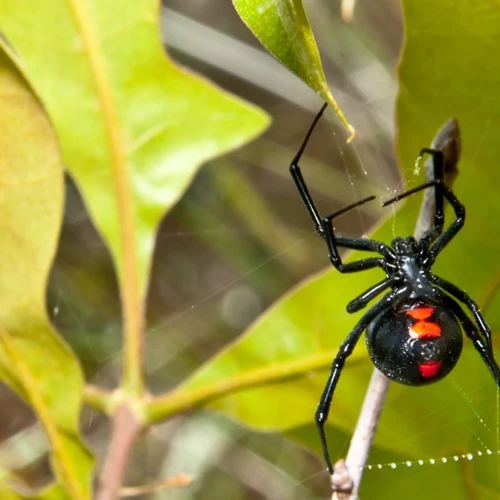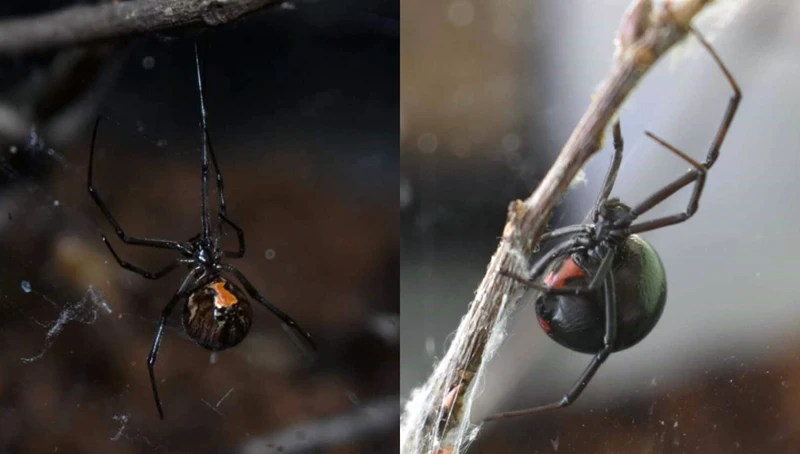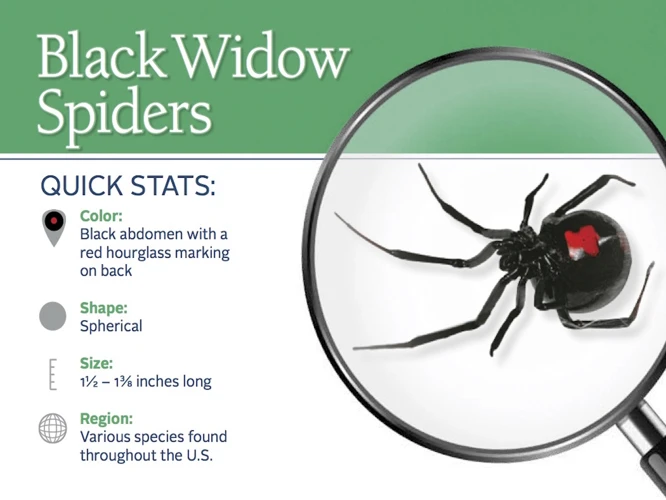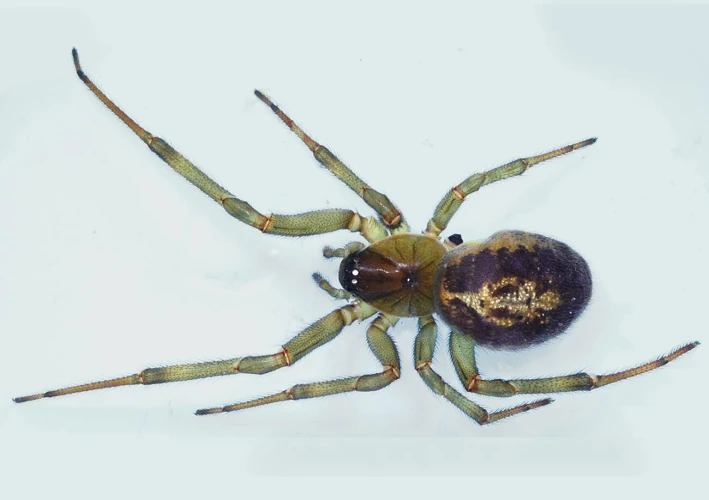As humans, we have a tendency to fear creatures that we do not understand. One such creature that has been given a bad reputation is the black widow spider. For years, there has been a belief that these spiders invade homes and buildings in search of their next victim. But is this really true? In this article, we aim to debunk the myth surrounding black widow spiders and inform you about their physical characteristics, behavior, and preferred habitats. We will also provide tips on how to protect yourself from black widows and address common misconceptions about these fascinating spiders. So, let’s delve into the world of black widows and separate fact from fiction.
What are Black Widow Spiders?

It’s impossible to talk about the myth of black widows invading homes and buildings without knowing what exactly a black widow spider is. These venomous spiders are known for their distinctive features, including the red hourglass-shaped marking on their abdomen. But, what else do we know about them? In this section, we’ll explore the physical characteristics and behavior of black widow spiders to help you understand the truth behind the myth.
Physical Characteristics of Black Widows
Black widows are known for their distinct physical appearance, which can help in identifying them. Here are some of their key physical characteristics:
- Size: Female black widows are typically larger than males and can reach up to 1.5 inches in length. Males are usually only about half the size of females.
- Color: Black widows are typically black or dark brown in color, with a shiny, hairless appearance.
- Markings: The most recognizable marking of the black widow is the red hourglass shape on the underside of the female’s abdomen. However, not all black widows have this marking, and some may have different markings or coloration.
- Legs: Like all spiders, black widows have eight legs. Their legs are usually long and thin and are covered in fine hairs.
It’s important to note that not all spiders with similar appearances to black widows are actually black widows. To differentiate between black widows and similar spiders, it’s important to closely examine their markings and other physical characteristics. Additionally, not all female spiders are black widows, as there are many species that can look similar.
While black widows are feared for their venomous bites, it’s important to remember that they do not actively seek out human interaction. Understanding their physical characteristics can help in identifying and avoiding potential encounters with them.
Behavior of Black Widows
Black widow spiders are known for their distinctive behavior. Here are some of their most notable behaviors:
1. Web-building: Black widows are well-known for their intricate web-building skills. Their webs are typically tangled and irregular, but can be strong enough to trap unsuspecting prey. They usually build their webs in hidden places such as under rocks, ledges, or within woodpiles.
2. Hunting Methods: Black widows use their webs to catch their prey such as insects, beetles, and other small spiders. They typically wait patiently in their webs for prey to come their way, and then quickly immobilize their victim with venom.
3. Feeding Habits: Black widows feed primarily on insects, but larger spiders and small mammals may also fall victim to their deadly venom. The venomous bites help them to break down their prey’s internal organs. They then consume the liquidized content by using their powerful jaws.
4. Reproduction: Black Widow spiders are famous for their ability to mate multiple times. After mating, the female may eat the male, although this is a rare occurrence in nature. Mating does not aid in females’ survival rates, but allows the males to transmit their sperm.
5. Defensive Behavior: Black widows are not aggressive and will only bite humans if they feel threatened. They will retreat and hide when disturbed, but will not hesitate to bite if they feel they are being attacked.
If you want to read more about black widow spiders, you can read about the truth behind black widow spider bites and their symptoms and treatments by following the link /black-widow-spider-bite-symptoms-treatment-truth/ in our article.
The Myth of Black Widows Invading Homes and Buildings

Dispelling the Notion of Black Widow Invasions in Homes and Buildings
Many people have a deep-seated fear of black widow spiders, largely due to myths surrounding their behavior and habitat. One of the most common misconceptions about these spiders is that they frequently invade homes and buildings, posing a threat to humans and pets. However, this perception is largely unfounded, and the reality is quite different. Let’s take a closer look at the origins of this myth and why it does not hold up under scrutiny.
Origins of the Myth
The myth of Black Widows invading homes and buildings is a widespread belief, but it is not a fact-based one. The roots of this myth are not entirely clear, but one possible explanation is that it arises from a general fear of spiders or a lack of understanding about Black Widows’ habitats and behavior.
Another possible explanation for this myth is the portrayal of Black Widows in popular culture. These spiders are often depicted as aggressive and dangerous predators, capable of killing humans with a single bite. While it is true that Black Widows can be poisonous to humans, they typically only bite when they feel threatened or cornered. Their venom is rarely lethal to healthy adults and is much less dangerous than that of other venomous animals such as snakes or scorpions.
Another source of this myth is likely misunderstandings of Black Widows’ habits and the conditions they prefer. These spiders are more likely to be found in warm, dry, and undisturbed areas, such as garages, sheds, or woodpiles. They do not actively seek out human dwellings and typically avoid areas with high foot traffic or frequent disturbances.
It is also possible that misidentifications or confusion with other spider species have contributed to the Black Widow invasion myth. Spiders such as the Desert Recluse or the False Black Widow have similar physical characteristics to Black Widows and may be mistaken for them by untrained observers. However, these spiders are not as widespread or as dangerous as Black Widows, and they do not have the same reputation for invading homes and buildings.
The myth of Black Widows invading homes and buildings is not based on verifiable facts. Rather, it appears to stem from a combination of fear, misinformation, and misunderstanding about these spiders and their behavior. By learning more about Black Widows and the reality of their preferred habitats, people can better protect themselves and separate fact from fiction.
The Reality of Black Widows’ Preferred Habitats
The Reality of Black Widows’ Preferred Habitats
Despite the myth that black widows invade homes and buildings, they actually prefer to build their webs in undisturbed outdoor areas. Black widows are commonly found in rocky crevices, piles of stones, and woodpiles. They also like to build their webs in low-lying shrubs and plants, and in tall grasses.
Black widows thrive in warm, dry climates, but can be found in most parts of the world. In the United States, they are commonly found in the southern and western states. They can also be found in Mexico, Central America, and parts of South America.
It’s important to note that black widows do not actively seek out humans and are not aggressive unless they feel threatened. In fact, they are known for being reclusive. Unless one stumbles upon a black widow’s web, it is unlikely that a person will come into contact with one.
Black widows are not likely to establish long-term infestations in homes or buildings. This is because indoor environments are not conducive to their preferred habitats. They prefer to build their webs in quiet, undisturbed outdoor locations where they can catch prey.
To summarize, the myth of black widows invading homes and buildings is just that – a myth. While they can sometimes be found indoors by accident, they do not actively seek out indoor environments. It is important to understand the reality of black widows’ preferred habitats in order to protect oneself from unnecessary fear and worry.
| Preferred Habitats: | Non-Preferred Habitats: |
|---|---|
| – Rocky crevices | – Indoor environments |
| – Piles of stones | – High-traffic areas |
| – Woodpiles | – Areas with bright light |
| – Low-lying shrubs and plants | – Areas with frequent movement |
| – Tall grasses | – Wet or damp environments |
If you want to know more about black widow myths and facts, check out our article on Black Widows: Fact or Fiction?.
How to Protect Yourself from Black Widows

Protecting yourself from black widows is important, especially if you live in an area where these spiders are commonly found. While black widows are not typically aggressive towards humans, their venomous bites can still cause serious health complications. In this section, we will discuss effective strategies for minimizing your risk of encountering black widows and preventing these spiders from taking up residence on your property. From removing black widow habitats to inspecting your home for signs of infestations, we will cover all the essential steps you need to take to ensure your safety. Let’s get started!
Removing Black Widow Habitats from Your Property
Removing Black Widow Habitats from Your Property
If you want to keep black widows away from your home and property, it is important to remove their preferred habitats. Below is a table of steps you can take to keep your property free of black widow spiders.
| Action | Explanation |
|---|---|
| Keep your yard tidy | Black widow spiders like to make their webs in cluttered areas with a lot of debris. Keep your yard tidy by frequently mowing the lawn, trimming the bushes, cutting back overgrown trees, and removing any unnecessary debris or items from your yard. |
| Seal all cracks and gaps | Black widow spiders can easily crawl into your house through small gaps and openings. Be sure to seal all cracks and gaps around windows, doors, pipes, and other openings with caulk or weather stripping. |
| Clean up any food or water spills | Like most pests, black widows are attracted to sources of food and water. Clean up any spills or messes in your home or garage, and make sure that all food is stored in airtight containers. |
| Use spider repellent products | Using spider repellents and insecticides around your property can help keep black widows at bay. Make sure to carefully follow the instructions on any products you use, and keep them out of reach of children and pets. |
By taking these simple steps, you can significantly reduce the likelihood of black widow spiders making themselves at home on your property. For more information on black widows and other similar spiders, check out our article on separating black widows from similar spiders.
Inspecting Your Home for Black Widows
Inspecting Your Home for Black Widows
While black widows usually prefer to reside in outdoor environments, they may occasionally find their way into homes and buildings. To check if your home has any black widows, it’s important to conduct regular inspections, especially in areas where they are more likely to reside. Here are some tips for inspecting your home for black widows:
| Area to Check | What to Look For | What to Do |
|---|---|---|
| Outdoor Areas | Dark, sheltered areas such as woodpiles, sheds, and garages where black widows may build webs. | Wear gloves and protective clothing, and carefully remove any spiderwebs or egg sacs. Seal up any cracks or openings where spiders can enter. |
| Indoor Areas | Cluttered, undisturbed areas such as closets, basements, and attics. | Use a flashlight to carefully inspect all corners, ceilings, and areas around pipes or vents. Remove any spiderwebs or egg sacs while wearing gloves and protective clothing. |
| Furniture and Bedding | Dark, warm areas such as inside bed linens, underneath cushions, and in the folds of clothing. | Shake out all bedding and clothing before use, and check for any signs of black widow webs or spiders. When sitting on furniture, use a flashlight to carefully inspect the area around and underneath cushions. |
Remember, black widows are typically not aggressive and will only bite if they feel threatened. However, it’s important to take precautions and remove any potential habitats to prevent any unwanted encounters. If you do find a black widow in your home, it’s best to call a professional pest control service to safely remove it.
What to do When You Encounter a Black Widow
Encountering a black widow can be a scary experience. However, it is important to remain calm and know how to handle the situation. Here are some tips on what to do when you encounter a black widow spider:
| Step | Action to Take |
|---|---|
| Step 1 | Do not panic or make sudden movements, as this can startle the spider. |
| Step 2 | Back away slowly, while keeping an eye on the spider’s location. |
| Step 3 | If the spider is inside your home, use a container to capture it. Wear gloves and gently place the container over the spider, then slide a piece of paper underneath to trap it inside. |
| Step 4 | Release the spider outside, away from the home, in a natural habitat. It is important to avoid killing the spider, as they play an important role in controlling insect populations. |
| Step 5 | Monitor the affected area for symptoms of a black widow spider bite, which can include nausea, muscle cramps, and sweating. If you experience any of these symptoms, seek medical attention immediately. |
It is also important to remember that black widow spiders will not usually attack unless provoked or threatened. If you do not bother them in their natural habitat, they will not bother you. By understanding how to handle an encounter with a black widow spider, you can protect yourself and safely release the spider back into its natural environment.
Common Questions and Misconceptions About Black Widows
Separating Fact from Fiction: Common Questions and Misconceptions About Black Widows
With their venomous reputation and distinctive markings, black widow spiders have been the subject of many myths and misconceptions over the years. In this section, we’ll answer some of the most common questions about black widows and explore the truths behind the rumors. Whether you’re worried about encountering a black widow in your home or just curious about these fascinating arachnids, we’ll provide the information you need to separate fact from fiction. Let’s get started!
Do Black Widows Really Eat Their Mates?
Are All Female Spiders Black Widows?
Are All Female Spiders Black Widows?
Contrary to the popular belief, not all female spiders are black widows. In fact, black widows are just one type of spider species among approximately 46,000 species of spiders found worldwide. Each spider species has its unique physical characteristics, behavior, habitat, and venom type.
All female black widows are easily identifiable due to their shiny black bodies and the characteristic red hourglass-shaped mark on the underside of their abdomen. This mark is an indication that the spider you have encountered is indeed a black widow. However, not all black widow species have this mark, so it’s essential to be familiar with other physical traits of black widows, such as their size and color patterns.
Some other spider species that closely resemble black widows include the false black widow spider and the redback spider. Both these species have similar physical characteristics to the black widow, but their venom is less harmful to humans.
It’s vital to understand that not all spiders are harmful to humans, and in fact, most species are beneficial as they feed on pests such as flies and mosquitoes, which can spread diseases. It’s crucial to learn about different spider species and how to distinguish them from each other to avoid any misidentification and unnecessary panic.
For more information about black widow spiders, you can read our article on black widow spiders’ red hourglass markings, or check out our article on exploring the benefits of black widow venom to learn how scientists are using it for medicinal purposes.
Are All Black Widows Dangerous?
Despite their fearsome reputation, not all black widows are dangerous. In fact, only the female black widow is venomous, and while all females have venom, not all venom is the same in terms of potency. The severity of the black widow’s bite depends on the species, the size and age of the spider, and the amount of venom injected.
There are five species of black widow spiders in the United States, and while they all have venom, only the females are considered dangerous to humans. Within the species, the level of danger can vary. The southern black widow, for example, has a stronger venom than the more common western black widow.
It’s important to note that black widows are not naturally aggressive toward humans and will generally only bite in self-defense. However, if threatened or provoked, a black widow may bite, and her venom can be extremely potent. Symptoms of a black widow bite can include pain at the site of the bite, muscle cramps and spasms, nausea, and a rise in blood pressure. In extreme cases, a black widow bite can even be fatal, particularly for young children, the elderly, and those with weakened immune systems.
It’s important to remember that, while black widows can be dangerous, they are also an important part of the ecosystem and play a role in controlling insect populations. It’s best to avoid handling them, but if you must, do so with caution. It’s also important to learn to recognize black widows’ preferred habitats and take steps to avoid them, including removing clutter and debris from around your home and sealing cracks and crevices where spiders could enter. By taking these simple steps, you can protect yourself and your family from black widow bites and live in harmony with these fascinating creatures.
Internal html link: black widows poisonous spider myth
Do Black Widows Eat Their Mates?
One of the most common misconceptions about black widows is that they eat their mates after copulation. While this may be true in some cases, it is not a universal behavior among all black widow spiders.
Here are some facts about the mating habits of black widows:
- Male black widows often engage in a complex courtship ritual before mating with a female. This ritual involves vibrating the web of the female and producing pheromones to attract her.
- During copulation, the male typically inserts his pedipalps (small, leg-like structures near the mouth) into the female’s genital opening. The transfer of sperm can take several hours to complete.
So, do black widows eat their mates?
The answer is, it depends. While there are documented cases of female black widows consuming their mates, it is not a behavior that is always observed. In fact, scientists believe that mate-cannibalism is more likely to occur in laboratory settings than in the wild.
There are a few theories as to why mate-cannibalism might occur in some black widow populations. One hypothesis is that it is a way for the female to gain additional nutrients that she may need for egg production. Another theory is that it may be a way for the female to avoid mating with inferior males.
In conclusion: While black widows have a reputation for being dangerous and aggressive, they are actually quite shy and prefer to avoid interaction with humans. As for the myth of mate-cannibalism, it is just that – a myth. While it is true that some female black widows have been known to consume their mates, it is not a universal behavior and occurs under specific circumstances. For more information about black widows and their habits, read on here.
Conclusion
After exploring the reality of black widow spiders and debunking the myth of their invasion into homes and buildings, it’s clear that they are not the menacing creatures they are often portrayed to be. While it’s important to take precautions and protect oneself from their venomous bites, it’s also important not to let fear of them take over.
If you encounter black widows on your property, removing their habitats and inspecting your home can help prevent their presence. If you do come across one, it’s best to remain calm and take appropriate measures to remove it without harming yourself or the spider. Remember, not all female spiders are black widows, and not all black widows are dangerous.
It’s important to educate oneself on the realities of black widow spiders and dispel any misconceptions or myths surrounding them. By understanding their behavior and preferred habitats, we can coexist with these spiders without letting fear overtake our lives. And, who knows, maybe even appreciate their role in our ecosystem as effective pest controllers.
For more information on the true capabilities and behaviors of black widow spiders, check out our articles on black widow hunting and feeding myths and realities, and whether black widow spiders can kill a human.
Frequently Asked Questions
What is the lifespan of a black widow spider?
The average lifespan of a female black widow spider is approximately 1-3 years, while males typically live only a few months.
Are black widows only found in the United States?
No, black widow spiders can be found throughout the world in warm, temperate regions.
Do black widow spiders bite humans often?
No, black widow spiders are generally shy and will only bite humans if they feel threatened. Bites are not common, but can be dangerous.
Can black widow spider venom be fatal to humans?
In rare cases, black widow spider venom can be fatal to humans, particularly for children, elderly individuals, and those with weakened immune systems.
What do I do if I find a black widow spider in my home?
Contact a pest control professional to safely and effectively remove the spider and prevent future infestations.
What do black widow spiders eat?
Black widow spiders primarily eat insects, but will also consume other spiders and small animals.
Can black widows be kept as pets?
No, it is not recommended to keep black widow spiders as pets due to their venomous bites and potential danger to humans.
Are there any natural predators of black widow spiders?
Yes, some predators of black widow spiders include wasps, birds, and other spiders.
Can I use insecticides to kill black widow spiders?
Insecticides can be effective in killing black widow spiders, but it is recommended to seek the assistance of a professional pest control service for safety and effectiveness.
How can I prevent black widow spiders from entering my home?
Sealing cracks and crevices, removing clutter and debris from around the home, and keeping outdoor lights off at night can all help to prevent black widow spiders from entering your home.






